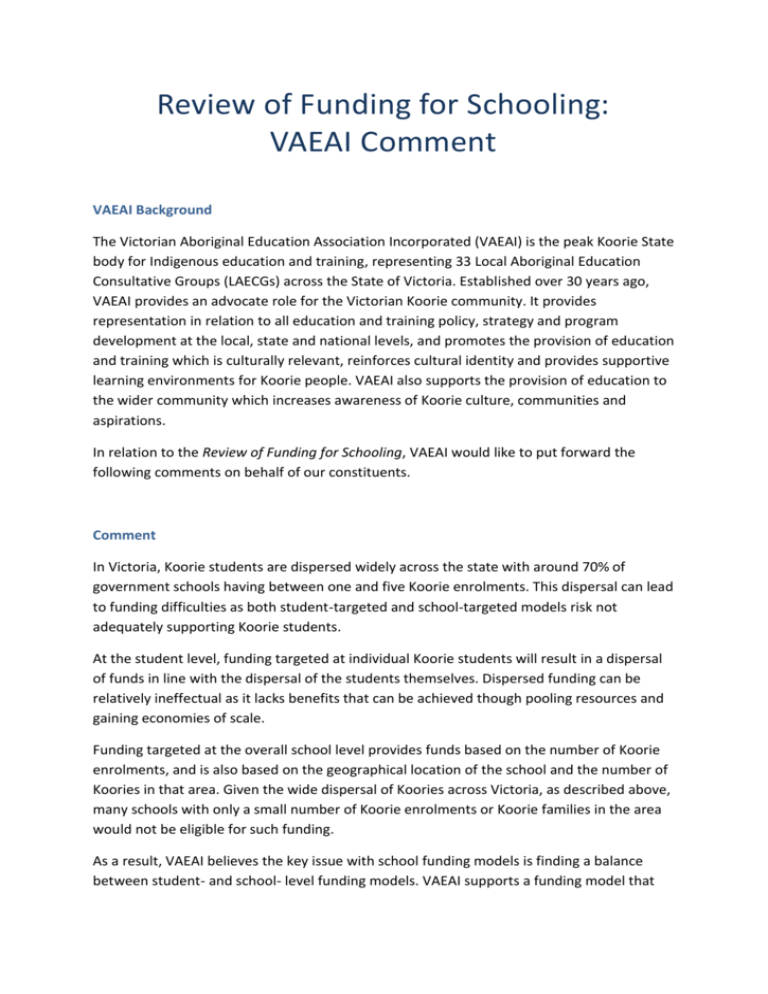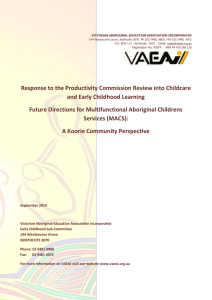Review of Funding for Schooling - Victorian Aboriginal Education
advertisement

Review of Funding for Schooling: VAEAI Comment VAEAI Background The Victorian Aboriginal Education Association Incorporated (VAEAI) is the peak Koorie State body for Indigenous education and training, representing 33 Local Aboriginal Education Consultative Groups (LAECGs) across the State of Victoria. Established over 30 years ago, VAEAI provides an advocate role for the Victorian Koorie community. It provides representation in relation to all education and training policy, strategy and program development at the local, state and national levels, and promotes the provision of education and training which is culturally relevant, reinforces cultural identity and provides supportive learning environments for Koorie people. VAEAI also supports the provision of education to the wider community which increases awareness of Koorie culture, communities and aspirations. In relation to the Review of Funding for Schooling, VAEAI would like to put forward the following comments on behalf of our constituents. Comment In Victoria, Koorie students are dispersed widely across the state with around 70% of government schools having between one and five Koorie enrolments. This dispersal can lead to funding difficulties as both student-targeted and school-targeted models risk not adequately supporting Koorie students. At the student level, funding targeted at individual Koorie students will result in a dispersal of funds in line with the dispersal of the students themselves. Dispersed funding can be relatively ineffectual as it lacks benefits that can be achieved though pooling resources and gaining economies of scale. Funding targeted at the overall school level provides funds based on the number of Koorie enrolments, and is also based on the geographical location of the school and the number of Koories in that area. Given the wide dispersal of Koories across Victoria, as described above, many schools with only a small number of Koorie enrolments or Koorie families in the area would not be eligible for such funding. As a result, VAEAI believes the key issue with school funding models is finding a balance between student- and school- level funding models. VAEAI supports a funding model that provides a base amount of Koorie-targeted funding to all Victorian schools and an additional loading for each Koorie enrolment. This loading is irrespective of geographical location and SES level. Such a model would address issues regarding funding dispersal, ensure that each Koorie student is financially supported, would not require a minimum number of Koorie enrolments in order to be eligible for funding, and would ensure that schools with a higher number of Koorie enrolments receive a higher amount of total funding. In addition, schools without any Koorie enrolments would be able to utilise base level funding for Koorie study units, which are increasingly becoming an important part of the curriculum and will be mandated under the National Curriculum. Financial loading for Koorie students is currently in place within the Victorian TAFE system, and can therefore provide a practical model upon which school funding for Koorie students should be based. Whilst the models described above are input-driven models based on student identification as Aboriginal or Torres Strait Islander, the importance of output-driven funding models should not be discounted. Targeted funding to Koorie students and schools should be similarly linked to student academic performance. The importance of Community consultation in determining education targets is discussed below. Prior to 2008, Commonwealth school funding to States for Indigenous students under the Indigenous Education (Targeted Assistance) Act (IETA) was achieved through ‘tri-lateral’ agreements and negotiations between the Commonwealth, the State, and Indigenous Education Consultative Bodies (IECBs). Today, IETA funding is built into State budgets, which has both decreased the flexibility of Indigenous-targeted education funding and removed previous consultation with the IECBs such as VAEAI. Consequently, VAEAI supports a move back to the previous arrangement of ‘tri-lateral’ discussions, so as to involve greater Community consultation and enable the Community to set relevant and realistic Koorie student achievement targets that are aligned with Community and goals and needs at the local level. This is in contrast to current COAG education targets, which are often disconnected from local education realities and aspirations, as they are determined and defined at the national level. With reference to the future of IETA funding more broadly, all supplementary funding provided by the Commonwealth should place increased weight on proactive and outcomefocused measures that are developed though consultation with the Koorie Community. Current reactive funding, such as tutorial assistance which requires the student to be achieving at below the average minimum standard in order to access assistance, is inherently flawed and firmly planted within a ‘culture of low expectations’ that needs to be left behind.









